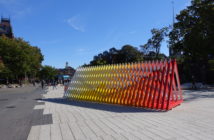Part of what makes us unique is that we contain bits of memories that belong to our histories and experiences. Yet we connect with each other and find solidarity through our being in the world. Even as people have become less religious in certain ways, they look for something beyond themselves to unite the fragments of their lives. In Temple of Mnemon, which was located on the Rose Kennedy Greenway this summer, Anne Lilly enables us to reflect on ourselves and transcendence at the same time. Viewer-participants must be stationed appropriately to experience this piece of art. Lying back on benches with a headrest and gazing upwards, contemplation slowly permeates the participant. About twelve feet above them, mirrors open and close mechanically, oscillating between their reflections and the sky. This continuous movement discloses the fragmentary impression of our lives, leaving us wondering how to be whole.

Anne Lilly, Temple of Mnemon. 2018. Courtesy of the artist.
Another entry in the philosophy and art series, I want to look at this work through the lens of Thomas Aquinas, a medieval philosopher. The idea that beauty is in the eye of the beholder is relatively new; it was more common in history to maintain that beauty had at least some objective qualities. Thus, Aquinas claimed that there are three conditions necessary for something to be beautiful: proportion, wholeness, and radiance. Proportion, simply put, comprises the harmony of the parts of an object. While proportion remains a prominent condition, I will focus here on wholeness and radiance.
Wholeness carries the idea that a particular thing is complete, not lacking anything essential to what it is. This condition carries metaphysical connotations, but this work suggests a more metaphorical intuition. Continuously uniting and dividing the viewer’s image, Temple of Mnemon tampers with the notion of one’s wholeness. If we are units of memory, then our identity is fragmented, as we cannot recall every part of our lives. Playing on that fragmentation, seeing and experiencing Temple of Mnemon causes us to look beyond ourselves but also at ourselves. While we may only remember and subsist as fragments, we are often juxtaposed with material and immaterial objects and ideas that are woven through other people and everything else. Luckily for us, the whole is greater than the sum of these remembered parts.

Anne Lilly, Temple of Mnemon. 2018. Courtesy of the artist.
Radiance is defined simply as what “holds the eye.” [1] It is the aspect of the object that draws viewers into the work and makes them want to continue to perceive it or perceive it again. Radiance also has to do with light as it creates the possibility of clarity, which is an essential ingredient to this work. In Temple of Mnemon, the mirrors close, the viewer’s reflection lights up the ceiling of the temple, but as the mirrors open again the light from above can offer transcendence. And this can even disturb the eyes, if the brilliant light from the sun pours through the openings. The feeling is that our individual light blends with the light around us.
While walking up to the Temple of Mnemon, you may not see a beautiful work of art in the unadorned brown beams and benches that comprise the sculpture. But as you subjugate yourself to the demands of lying back on the benches, the beauty of this piece is revealed above your head. Maybe it’s like a lot things, where you just need to know how to look at it. There is a sense in which you feel like you’re about to sink in the earth. I was reminded of Bukka White’s old blues song Fixin’ to Die. Whether there is a spiritual realm to exist in post-death, we need a feeling of transcendence here. And we are able to transcend any one memory by being the whole person comprised of those bits of memory, which Temple of Mnemon helps us to recognize.
[1] Etienne Gilson, The Arts of the Beautiful. Dalkey Archive Press, 2000.





1 Comment
Most interesting! At first glance, one would have walked right by and missed something special….something to personally experience. Although I don’t live in Boston, I usually visit once a year. Michael, you have increased my appetite for awareness as I make my way around the city. If I see a structure of sorts, I won’t walk by, but will observe it more closely, and perhaps experience something I may have missed otherwise.
Thank you, I enjoyed your article and look forward to reading more of them.